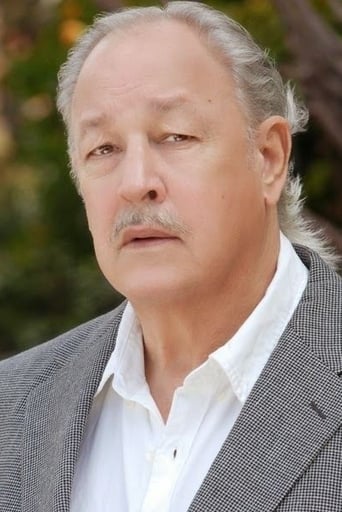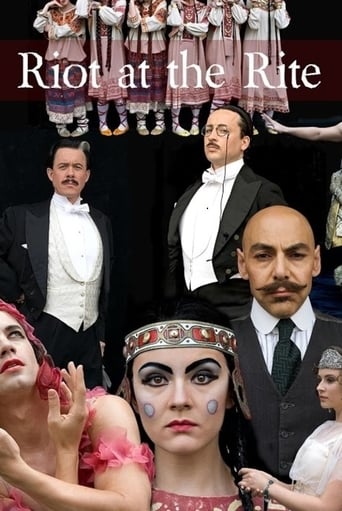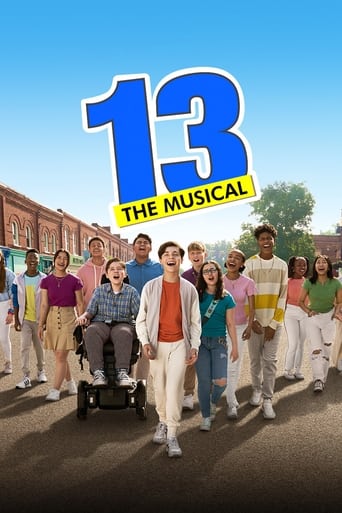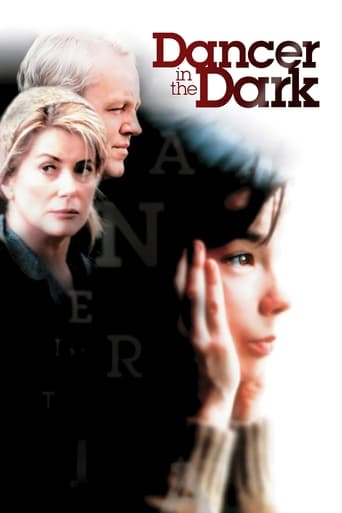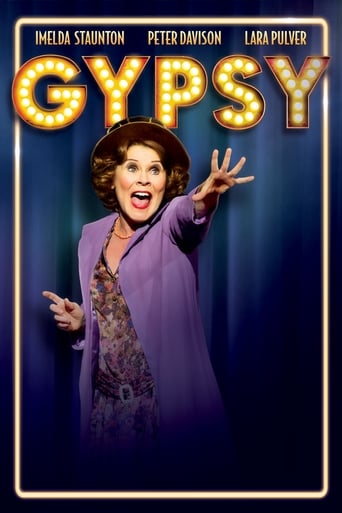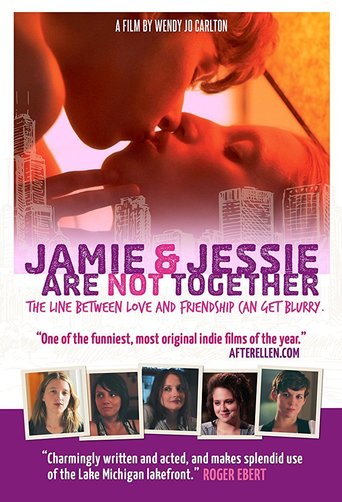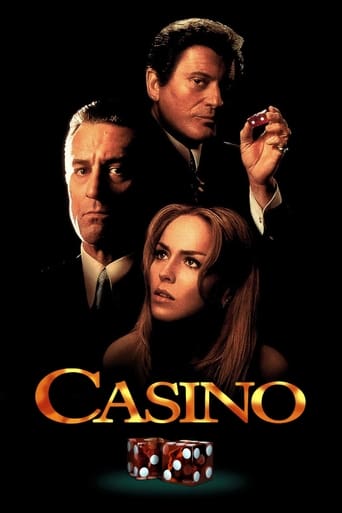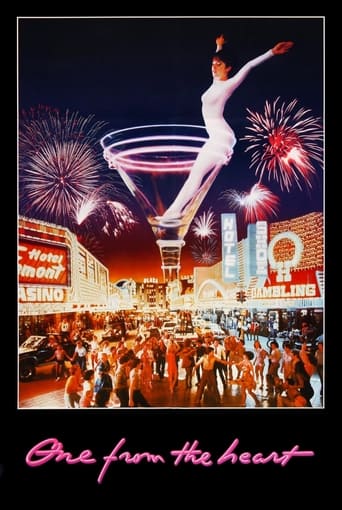
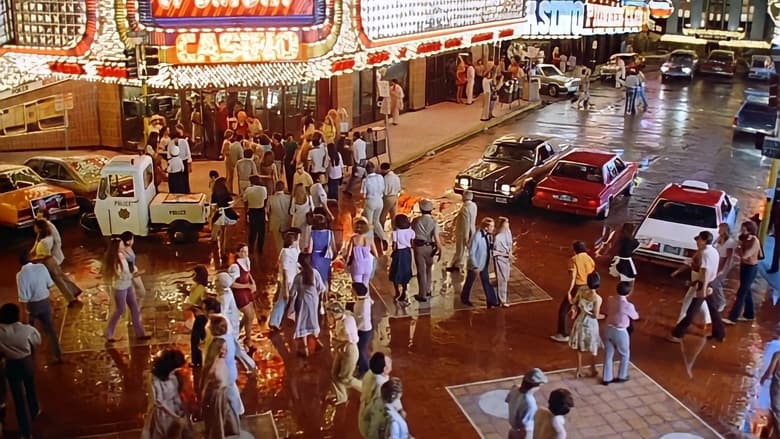
One from the Heart (2024)
Hank and Frannie don't seem to be able to live together anymore. After a five-year relationship, lustful and dreamy Frannie leaves down-to-earth Hank on the anniversary of their relationship. Each one of them meets their dream mate, but as bright as they may seem, they are but a stage of lights and colors. Will true love prevail over a seemingly glamorous passion?
Watch Trailer
Cast
Similar titles

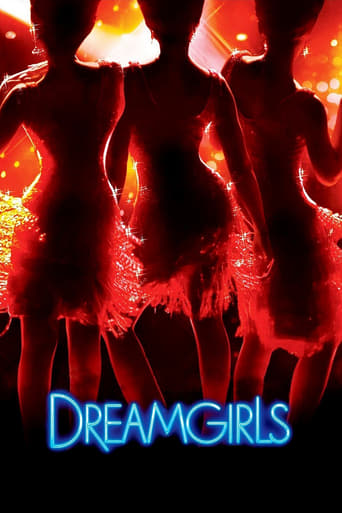
Reviews
Sorry, this movie sucks
Good , But It Is Overrated By Some
Fantastic!
Best movie ever!
In his series, My Year of Flops, Nathan Rubin said, "It's telling that when a filmmaker succeeds in running his own studio, it's because he's learned to let his inner businessman veto his inner artiste. Coppola ran Zoetrope with his heart. It nearly destroyed him." One from the Heart wasn't just director Francis Ford Coppola's dream project. It was his way of saying to producers like Robert Evans, who Coppola famously warred with as he made The Godfather, "Hey. I don't need you. I can control costs and production and make a movie all on my own."Somehow, One from the Heart went from a personal love story to a $28 million dollar epic. It went from a movie to a Quixotic odyssey. Or was that 1979's Apocalypse Now, a film that went from Joseph Conrad cover version to a sprawling epic that nearly killed several of the people in its orbit? From typhoons to nervous breakdowns, actors getting replaced mid-production, Martin Sheen having a heart attack, Marlon Brando showing up out of shape and not ready to perform, Dennis Hopper high on drugs before disappearing for days in the jungle and so much more, the film was delayed and delayed and delayed. The director himself succinctly put it this way: "We were in the jungle, there were too many of us, we had access to too much money, too much equipment and little by little, we went insane." Yet the movie that emerged was a classic.Now that Coppola was making a movie on his own terms, the odds were higher than they'd ever been before. The film had to be a winner with the public's hearts, minds and wallets.Coppola wanted to create something that he called Electric Cinema (I've also heard it called Live Cinema). There would be long takes, performances that felt like they belonged on the theater stage and cameras that would shoot from every angle to ensure coverage so that Coppola's editing team could craft magic from the wealth of available film. This technique - which involves modern video editing years before it was used or even feasible - isn't something that Coppola has given up on. He was part of what is said to be "an ambitious "Distant Vision" project as a "live cinema" experiment at his alma mater, the UCLA School of Theater, Film and Television" in 2016 and published a book, Live Cinema and Its Techniques, in 2017.Roger Ebert stated in his January 1, 1982 review, "Everybody knows that Coppola used experimental video equipment to view and edit his movie, sealing himself into a trailer jammed with electronic gear* so that he could see on TV what the camera operator was seeing through the lens. Of course, the film itself was photographed on the same old celluloid that the movies have been using forever; Coppola used TV primarily as a device to speed up the process of viewing each shot and trying out various editing combinations." In short, Coppola did exactly what every modern production does today, particularly commercial shoots, using a more advanced version of the Video Assist that Jerry Lewis claimed to have invented (in truth, Jim Songer was the patent holder, read more in this fascinating article).What emerged is a film that is just as much theater as it is a movie as it is live TV. It begins and ends with a curtain. And what is in-between is a mix between heartfelt passion and pure cinematic gloss. Everything that can be neon will be - even the names of the cast and crew. Yet the story that is told is between two people and could happen to anyone.This isn't the real Las Vegas, though. This is the Vegas of movies, of dreams, of what Vegas feels like but can't be. It's a world where the music of Crystal Gayle and Tom Waits provide their voices, as the film becomes a musical. Kind of. Sort of.Hank (Frederic Forrest, The Rose, Apocalypse Now) and Frannie (Teri Garr, Close Encounters of the Third Kind, Young Frankenstein) are a couple who've been together too long. Five years too long. They're sick of one another, they've left another one too many times and now, this is the end of their story.They spend their fifth anniversary with their dream lovers. Hank falls for Leila, who is youth and beauty and pure sex (it's no accident that Nastassja Kinski plays her). Frannie picks the dark, handsome and mysterious Ray (Raul Julia, who I really don't want to say is also in Street Fighter, but he was), a man who will give her what she always wanted: he will sing to her.It's not enough for Hank, who tracks down Frannie and tells her that he loves her, but she refuses his advances. He even follows her to the airport, where she is due for Bora Bora with her new lover, ready to leave reality behind for a life of idyllic passion. He tries to sing to her in his cracked voice but leaves in tears.Back in their broken home, he's lost, but she comes home to him, realizing that they are meant to be together.My question is, "Why?" The film never shows us why the real world is better than a dream. Would you choose a ramshackle house and a life of arguments over dancing with Julia or a neon sign graveyard with Kinski gyrating against a Technicolor sky? No. You wouldn't.That's my main issue with One from the Heart. Its heart seems in the wrong place, that these two mismatched souls belong together when the film repeatedly shows us that no, they belong with their fantasies.Another nod to the stage is that the film features understudies, including Rebecca De Mornay. I'd also be remiss if I didn't call out one of the best parts of the film - Harry Dean Stanton, who elevates every single piece of film he ever wandered into. Here, he's the owner of the neon graveyard.What amazes me is that Coppola would try to direct another musical, particularly after his work on 1968's Finian's Rainbow led many in Hollywood to brand him as someone who was hard to work with and hard to keep on budget. Again, I turn to the superior words of Nathan Rabin, who had this to say about the film: "As Coppola tells it on Finian's Rainbow's shockingly candid audio commentary, he was the wrong man for the job in every conceivable way. Coppola fancied himself a New Wave-style auteur. Warner Bros saw him as a cheap gun-for-hire."While One to the Heart was intended as a small follow-up to Apocalypse Now, obviously things didn't turn out that way. For Coppola, it meant going back to the studio system. Every movie he made for almost two decades - The Outsiders, The Godfather: Part III, Jack, The Rainmaker and even a return to working with Robert Evans (this one's a whole other tale in and out of itself) on The Cotton Club was all to pay back the debts from this film.Should you see it? You better after I wrote over 1,200 words about it! But seriously, the color palette of this film is something you won't see outside of Suspiria. It's a music video in an era where that art form was still growing. And it informs later works like Bram Stoker's Dracula, which is even more overt in its reference to the works of Mario Bava than simply loving his brighter color choices. And if you watch this on DVD, you even get the choice to simply watch the musical numbers, which may improve on the film for some.*Indeed, Coppola would direct a lot of the film from "The Silver Fish, a mobile HQ, fully equipped with a kitchenette, espresso machine and onboard Jacuzzi," which had a loudspeaker that he could issue orders from. Insane. And by insane, I mean brilliance.
Coppola's follow-up to Apocalypse Now and his first film at his newly developed American Zoetrope studio, this was supposed to procure his everlasting success as a great American auteur (it probably wasn't even in doubt at the time). Unfortunately, the film turned out to be a huge money pit, was poorly reviewed and did poorly at the box office. Pretty much every film Coppola made afterward was to pay off debts due to this movie. That history weighs heavily on the film, but, really, it's quite lovely. Not a masterpiece, but it's quite lovable. Frederic Forrest and Terri Garr star as a couple in Las Vegas. They get in a fight, break up, find new lovers (Raul Julia and Nastassja Kinski), but still have a connection. It's a very simple story, and honestly a pretty thin one, but it's a charming little romance. What makes the film memorable, though, is the gorgeous production design - Las Vegas re-created in a studio setting. It's very artificial and very eye-popping. The other notable element is the song score, written by Tom Waits. The film is a true treat for Waits fans, who got an Oscar nomination for it (I can't imagine what he possibly lost to!).
Those new wave filmmakers who revolutionised Hollywood during the 1970s were among the first generation of film geeks – people who got into the movies because they loved being at the movies. That's why, when people like Martin Scorsese, Steven Spielberg and Francis Ford Coppola started getting the cash and influence together to fund their own personal projects in the 1980s, they were liable to blow inordinate sums of money on homages to the cinema they had grown up on. It's odd, because these new wave directors and their work were in many ways the antithesis of classic Hollywood and its ways of doing things.In One for the Heart, writer-producer-director Coppola attempts homage to 1950s musicals like Singin' in the Rain and Guys and Dolls, swing-time romances in which city streets would be recreated in studios for that glitzily artificial look. However, rather than commission a score for the characters to sing, Coppola follows the trend of more recent Bob Fosse musicals, and One from the Heart's numbers are a non-diagetic commentary on the action. This is not a bad idea in itself, except that the music here is especially unmemorable and lacklustre. The songs sound like the end of a bad night out, with Tom Waits voice like the drawl of some predatory sex pest. This is not stuff you'll be singing on the way home.As a director Coppola seems to have mistaken the exaggerated look of the picture's influences for one of bluntness. Often the sets are drenched in coloured lighting, which sometimes changes within the shot, seemingly to highlight contrasts between the two leads and their environments. This and things like having the camera impossibly far back from the leads at their end of their first scene simply look obvious and overdone. On the other hand Coppola does at least display some musical sensitivity (as he did in the more conventional and very good Finian's Rainbow from 1968). The peak of the picture is during the extended music and dance sequence in the middle, in which Coppola shows incredible detail in the handling of the crowd, flashing various extras across the foreground in complement to the score.But there is little else one can say in One for the Heart's favour. The acting performances are mostly dull, and whenever they do broaden out a bit they verge on the silly. The story is hardly inspiring, and we never really sympathise with the characters because they are not made especially likable in the first place. The dialogue is lousy. Coppola had a great idea, but he did not follow it up with one single thought, and the picture works neither as a classic-style homage nor as an updated take on the genre. The musicals of old had a fairytale quality to them. This modern romantic drama, with its swearing, nudity and blazing rows, is mixed with the fake sets and ensemble dance routines like some bizarre and botched Frankenstein's monster. Coppola would now spend years trying to pay off his debts with routine features, and still has yet to rediscover the cinematic gold he struck in the 1970s, with which he had made his name and fortune.
Dreamy ! Sedate and defined ! I first watched this movie when I was on my own and it made me think of my girlfriend .It is so fantasy in a modern day setting that it cannot fail to enchant .I don't know if it is charming or stark but it does have realism in an unreal state .The story is simple but nevertheless believable .You know how they feel ! It is one of my favourites and it takes me away to a fantasy place - I have not taken drugs but I imagine that this is what is would be like .It is a fantasy world of warmth and seduction , bright and shiny coupled with building site realism and everyday feelings .You truly suspend realism and that is what films are supposed to be about .If you are looking to escape for a couple of hours , watch this

